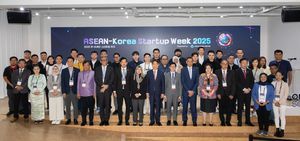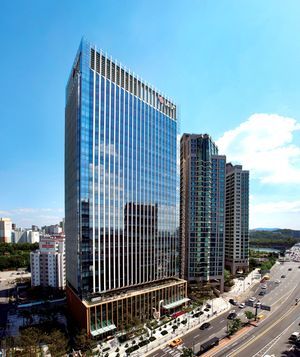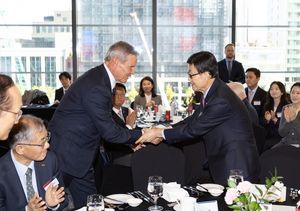![A samsung logo flag hangs outside the company]](https://contents-cdn.viewus.co.kr/image/2025/07/CP-2023-0309/30884330.jpg) As concerns over a potential oversupply in the high-bandwidth memory market for AI semiconductors mount, South Korea’s memory chip giants Samsung Electronics and SK hynix have experienced markedly divergent stock performances.
As concerns over a potential oversupply in the high-bandwidth memory market for AI semiconductors mount, South Korea’s memory chip giants Samsung Electronics and SK hynix have experienced markedly divergent stock performances.
Market analysts attribute this divergence to growing worries over oversupply and price erosion in the HBM segment—a critical component in AI chipsets. Foreign investors, in particular, have been offloading SK hynix shares given the company’s dominant position in the global HBM market.
Samsung’s entry into the sixth-generation HBM chip market, dubbed HBM4, is expected to erode the price premium that SK hynix has enjoyed with its fifth-generation HBM3E products.
“We’re observing increasing concerns about a potential HBM oversupply beginning this year,” said Ryu Young-ho, senior analyst at NH Investment & Securities. “This has triggered a sell-off in SK hynix shares.”
Meanwhile, Samsung Electronics’ shares—which had long lagged behind those of SK hynix—have started to rebound after securing supply deals for both HBM3 and HBM3E with AMD and Broadcom, signaling renewed confidence in its technological prowess.
“If Samsung manages to break into Nvidia’s HBM supply chain, it could further aggravate the oversupply issue,” Ryu added. Currently, SK hynix holds 53 percent of the global HBM market, while Samsung trails at 38 percent. The entry of Micron is set to intensify the competition even further.
Samsung shares are also buoyed by expectations of increased HBM revenue, bolstered by the recent lifting of export restrictions on Nvidia’s China-specific AI chip, the H20. As new markets emerge, Samsung’s position in the HBM arena appears to be strengthening.
Industry observers are keenly watching to see whether the HBM sector will shift from a technology race to a price war. Until recently, tight supply allowed manufacturers to set prices. However, as supply increases, tech giants like Nvidia and AMD are likely to gain the upper hand in price negotiations.
“We’re witnessing a power shift from suppliers to buyers,” noted Ryu. “This could lead to more modest price increases for upcoming HBM4 chips than initially expected.”
Goldman Sachs forecasts a potential 10 percent drop in HBM prices next year, citing increased competition and expanded capacity.
“The HBM market is maturing,” an industry insider, speaking on condition of anonymity, told us. “As supply constraints ease, chipmakers will need both technical excellence and competitive pricing to stay in the game. We’re likely to see a real price war break out next year.”
In this environment, both Samsung and SK are racing to mass-produce HBM4 by year’s end.
SK was first to act, supplying 12-layer HBM4 samples to Nvidia in March. Samsung is expected to follow suit this month, shipping samples to both Nvidia and AMD.
To regain ground lost due to HBM3E delays, Samsung is leveraging its advanced 1c DRAM technology—which employs a 10-nanometer process—for HBM4 production. The company is aiming for high precision and yield stability while ramping up investment in its Pyeongtaek Campus Line 4 (P4) to support volume production.
“Samsung appears to be taking a long-term approach to rebuilding customer trust, rather than chasing quick wins,” an industry source familiar with the matter commented. “While Samsung might be playing catch-up in HBM development, if they can deliver on performance, they have a genuine shot at closing the gap with their rivals.”
For its part, SK is prioritizing stable yields by sticking with the 1b process—the fifth generation of 10nm technology—and continuing with the mass reflow-molded underfill packaging method used in HBM3E. The company is also deepening its partnership with Taiwan’s TSMC to enhance both HBM4 production and advanced packaging capabilities.
“We’re doubling down on open collaboration with global customers and TSMC,” said Kim Joo-sun, SK hynix’s president of AI infrastructure. “Our goal is not just to develop the highest-performing HBM4, but also to cement our position as the go-to provider for all AI memory needs.”










Most Commented